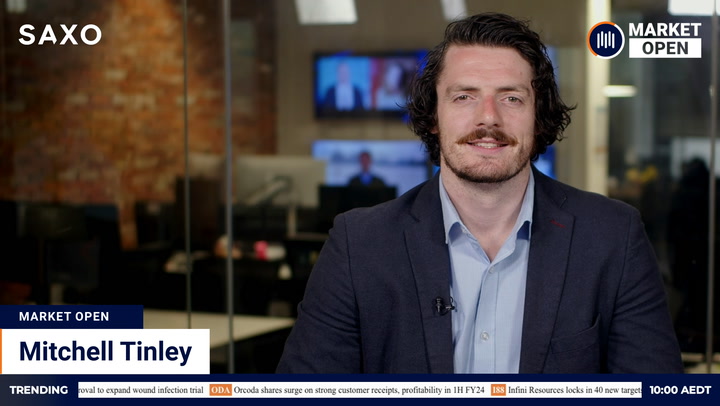Australian stocks were poised to start the week higher as investors balanced strength in commodities against declines on Wall Street.
The S&P/ASX 200 looked set to open 28 points or 0.39 per cent ahead, according to futures action. An advance of that size would reverse most of Friday’s 40.6-point loss.
US stocks fell as Ukraine’s slide into chaos overshadowed strong employment figures. Oil ended its strongest week on record with gains of around 26 per cent. Copper, aluminium, palladium, natural gas and coal hit all-time highs. Iron ore, nickel and gold also advanced.
Wall Street
US stocks sank as a fire at a Ukrainian nuclear power plant fuelled typical risk-off moves. Upbeat jobs data failed to gain traction as investors fretted over the risk of a nuclear incident on Europe’s eastern edge.
“Traders may be unwilling to hold risk over the weekend, given the reality of a hot war in Ukraine and that the situation can move in any direction,” Saxo Bank’s strategy team told clients.
The S&P 500 fell 35 points or 0.79 per cent to its fourth loss in five sessions. The Dow Jones Industrial Average dropped 180 points or 0.53 per cent. The Nasdaq Composite lost 225 points or 1.66 per cent.
Gold and the US dollar rallied even as authorities downgraded the threat from the fire at the Zaporizhzhia nuclear plant. A fire at a training building was reportedly extinguished without any threat to the reactors. Russian troops seized control of the facility.
The US booked its biggest increase in employment in seven months. The jobless rate fell to 3.8 per cent last month from 4 per cent in January. Nonfarm payrolls increased by 678,000, well ahead of the forecast 440,000.
“You couldn’t have asked for a better jobs report and yet the market is really taking it on the chin today,” Ellen Hazen, chief market strategist at FL Putnam, told MarketWatch. “The deteriorating situation in Ukraine is driving the markets.”
Energy was again the best of the sectors at the end of a record week for crude. US oil surged 26.3 per cent or US$24.09 last week, the biggest weekly dollar gain of all time.
The US energy sector climbed 2.85 per cent to its highest since 2018. Occidental Petroleum surged 17.59 per cent. Exxon Mobil put on 3.76 per cent and Diamondback Energy 2.74 per cent.
A decline in long-term interest rates pressured lenders. The yield on ten-year US treasuries revisited recent lows as investors reduced risk. Wells Fargo dropped 4.78 per cent, Bank of America 3.62 per cent and JPMorgan Chase 2.81 per cent.
Travel and tourism companies declined. United Airlines slumped 9.07 per cent and American Airlines 7.13 per cent. Cruise line Carnival shed 5.69 per cent, hotel chain Marriott 3.74 per cent and theme park operator Disney 3.33 per cent.
European markets logged heavy falls. The pan-European Stoxx 600 gave up 3.56 per cent. Britain’s FTSE 100 index lost 3.48 per cent, Germany’s DAX 4.41 per cent and Italy’s FTSE MIB 6.24 per cent.
Australian outlook
Australia’s status as a commodity exporter looks set to cushion it from the worst of the Ukraine global sell-off. While European markets trade at one-year lows and Wall Street hovers near correction territory, the S&P/ASX 200 still sits well above January’s “US rates tantrum” low.
The ostracization of Russian exports has fuelled huge gains in commodities, benefitting the ASX’s heavy weighting towards energy and materials. (Together the two sectors account for almost a third of the index.)
“The invasion has upended the markets, supply chains are ceasing to work, which means we have dislocations all over the place,” Ole Hansen, head of commodity strategy at Saxo Bank, said.
The top five movers on the domestic benchmark last week were all commodity producers: Whitehaven Coal, Woodside Petroleum, Lynas Rare Earths, South32 and BHP. Record highs in several commodities should see most of the mining sector well supported this session.
Commodity currencies, including the Australian dollar, rallied on Friday. The Aussie was this morning 0.24 per cent ahead at 73.64 US cents, near its strongest since November.
Energy was the pick of the US sectors, rising 2.85 per cent. Defensive bond proxies also drew a bid as falling yields encouraged interest in alternatives to bonds. Utilities gained 2.19 per cent, real estate 0.82 per cent and health 0.49 per cent.
The financial sector was the biggest drag, falling 1.96 per cent. Tech shed 1.78 per cent, materials 0.42 per cent and industrials 0.23 per cent.
The interim dividend season may act as a handbrake on the market this week as some of the index’s largest companies trade ex-dividend. CSL goes ex today, along with QBE, Bendigo Bank, Ramsay Health Care, Altium and Perseus Mining. Rio Tinto, Brambles, South32 and WiseTech go ex later in the week.
The economic calendar looks like this: job ads, services index (today); business confidence, weekly consumer confidence (Tuesday); consumer sentiment (Wednesday); and weekly payrolls (Thursday).
The rates outlook will be front and centre on Wednesday and Thursday when Reserve Bank Governor Philip Lowe first addresses a business summit, then takes part in a panel discussion at the Banking 2022 Conference.
On Wall Street, Friday’s consumer inflation report looks like the week’s biggest “risk event”, with the potential to swing the spotlight back onto the rates outlook. China releases inflation figures on Wednesday. A meeting of European leaders on Thursday could generate further sanctions against Russia.
IPOs: another thin week coming up. The ASX lists just three debutants this week: US Student Housing REIT (Tuesday); Catalano Seafood (Wednesday); and Pinnacle Minerals (Friday).
Commodities
US oil ended its best week on record at a level last seen in 2008. West Texas Intermediate firmed US$8.01 or 7.4 per cent to US$115.68 a barrel. The global benchmark, Brent crude, settled US$7.65 or 6.9 per cent ahead at US$118.11 a barrel. The weekly gain of 25.5 per cent was the strongest on records dating to 1991.
Copper hit an all-time high in the US amid fears of supply disruptions. Copper for May delivery hit US$4.949 a pound on Comex before settling 3.3 per cent ahead at US$4.938. Benchmark copper on the London Metal Exchange climbed 3.12 per cent to US$10,674 a tonne.
Palladium, a metal valued both for its appearance and for industrial applications, also hit a record. The metal settled US$251.10 or 9.2 per cent ahead at US$2,981.90 an ounce. Russia accounts for roughly 40 per cent of global production.
Nickel cracked US$30,000 a ton for the first time since 2008. Prices rose as much as 13 per cent on the London Metal Exchange before settling 7.52 per cent higher at US$28,919. For the week, prices increased 19 per cent.
Aluminium climbed 3.57 per cent to a fresh high. Lead gained 2.12 per cent, zinc 3.33 per cent and tin 2.43 per cent.
In other moves, wheat rallied 7.12 per cent to a 14-year high in Chicago, and Dutch gas and British coal futures set new highs.
Gold extended its gain for the week to 4.2 per cent. Metal for April delivery settled US$30.70 or 1.6 per cent higher at US$1,966.60 an ounce. The NYSE Arca Gold Bugs Index rose 3.3 per cent.
Iron ore ended a strong week with another up-tick as inventories at Chinese ports continued to decline. The spot price for ore landed in China edged up 60 US cents or 0.4 per cent to US$152.40 a tonne. For the week, the spot price at Tianjin jumped US$18.95 or 14.2 per cent.
BHP‘s US-traded depositary receipts edged up 0.16 per cent after its UK listing dipped 0.86 per cent. Rio Tinto slipped 2.52 per cent in the US and 1.65 per cent in the UK.





